What's up, fellow wizards? Today, we're going to be looking at a final table ICM concept: over-bet shoving on the flop.
So today, I want to have a look at a concept that is fairly new and that you don't really see too much in today's games—not even in high-stakes games by very good players. But with the advent of GTO Wizard ICM postflop AI solver, I suspect that in a year or two, we are going to see a lot of this play happening, especially at the higher stakes.
All right, so what is the concept exactly? Well, if you run a lot of postflop ICM spots, you will begin to see that the solver often wants to end the action already right there on the flop. It doesn't want to open itself up for either getting check-raised and facing a difficult decision on the flop, or have the turn bring a quote-unquote "scary card."
Today, I want to explore this topic to try to understand exactly when this happens most frequently and why. I also want to try to find a few nice heuristics that we can easily remember and implement in game when we are faced with such a scenario.
All right, so the first board we're going to look at is with a flush draw, button versus big blind.
Let's have a look at risk premiums first of all—I think that's a good place to start always. We can see that the big blind here has a 6.2% risk premium, and the button has 12.2%. So relatively low for the big blind, relatively high for the button—twice as big for the button here, which makes sense. He's covered by a lot, and there are some short stacks at the table.
Let's have a look at the button strategy here. We can see that he's playing two sizings: he's playing pot and he's playing all-in for 3.4 times pot, almost preferred sizing—all-in, just end the hand right now. Give me the pot.
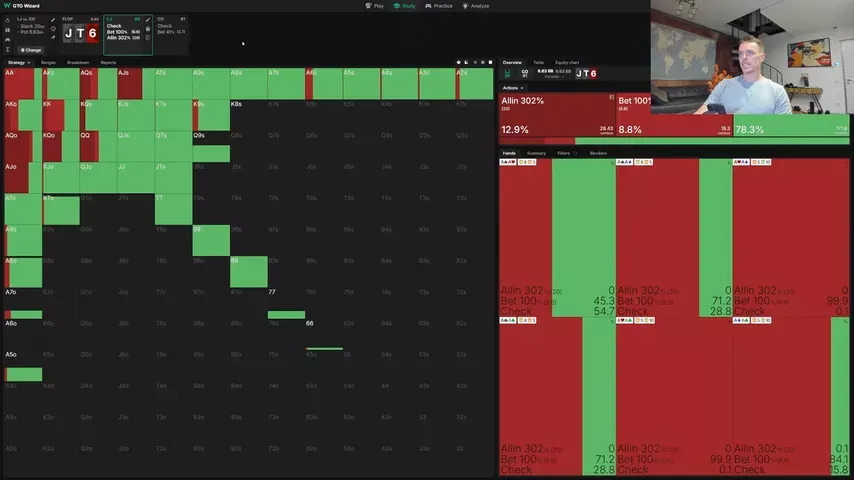
Very interesting to see. And what hands are we using in this all-in range? Let's have a quick look.
Firstly, the value range—it's kind of intuitive in the spot. I think we're using the biggest top pairs: Ace-9, King-9 offsuit and suited. And we're using the first overpairs, the most vulnerable overpairs: pocket tens, pocket queens.
I think what's less intuitive in this spot is where do we draw the bluffs from. It's kind of easy to assume that we're going to be using hands like 10-8, for example, open-ender, which we can see is pure checking, or hands like flush draws, like King-5 of spades, for example, would be an intuitive one since you're putting so much money into the pot. But we can see King-5 of spades also just pure checking. King-6 of spades sometimes betting but never jamming.
So what hands are we using? We're using ace-10 offsuit a lot. We're using king-10 offsuit, king-jack offsuit, queen-jack offsuit, queen-10 offsuit. We're using a lot of overcards that share cards with the value range—queen-10 offsuit, very good example, sharing cards with pocket queens and pocket tens.
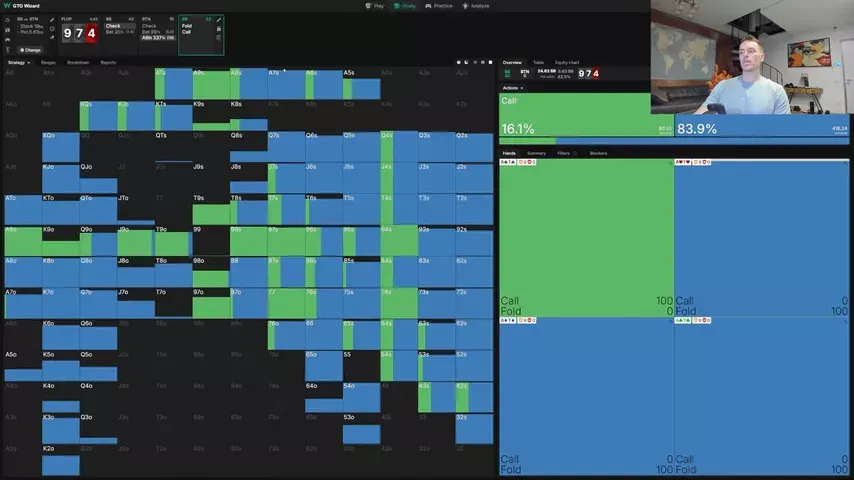
And why are we using these hands instead of our big draws? I think it's going to become apparent when we look at the big blind's calling range. So let's do that.
We jam, and he has to fold 84% of hands. He has to fold even some top pairs. Here, we can see he's folding 10-9 sometimes, Jack-9 sometimes, Queen-9 a lot. Why is he folding Queen-9 more than Jack-9 and 10-9? Because of backdoor straight equity with his hands.
Of course, he's also folding big draws like queen-six of spades, jack-six of spades. Very big hands here that have to hit the muck. 10-6 of spades is going to call because it has combo draw and enough equity. But yeah, a lot of really strong hands straight into the muck here. Very interesting to see.
All right, so the next spot I'm going to look at is lowjack jam versus cutoff single-raise pot (covered).
Player stacks:
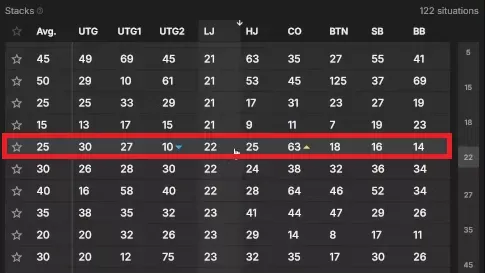
Flop – .
It's also a single-raise pot, but we're out of position this time. We're opening from the lowjack with 22 bigs, and the cutoff has flatted off 63. So again, let's have a look at risk premiums to begin with. Here, the lowjack has a very high risk premium—14%. The cutoff, not so much, almost 5%. He has a very big stack, so the lowjack can't really do that much damage to him.

We can see that the lowjack here mostly prefers to just take the pot down right now—3x pot all-in. Again, kind of a similar concept as before. The hands we're using here are our best top pairs: Ace-Jack suited, Ace-Jack offsuit, first overpair pocket queens. Then we're using overcard hands like Ace-Queen more than, for example, a nut flush draw. We can see Ace-7 suited, nut draw, just checks always, pretty much. Ace-Queen offsuit pretty much always just wants to go all-in. King-Queen offsuit, all-in.
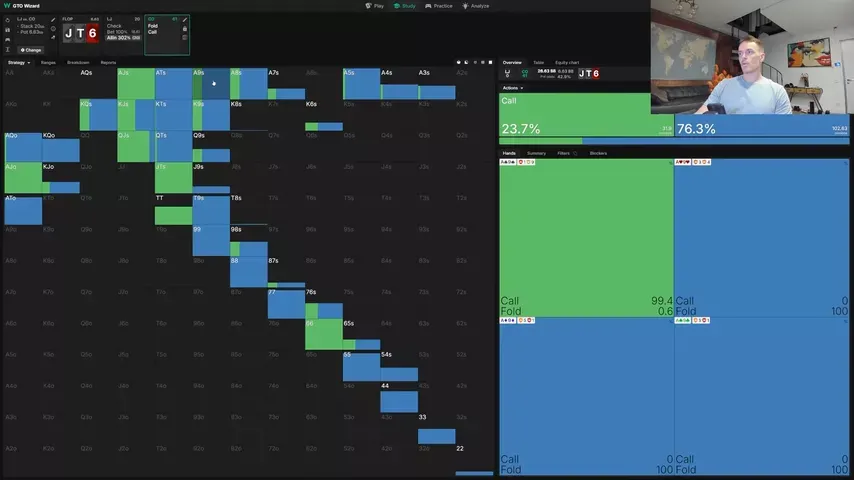
So again, let's see what's happening here. Why do we want to just go all-in with, for example, Ace-Queen offsuit? Here is the reason: we go all-in with Ace-Queen offsuit and get some really nice mega master effects. For example, we get called by Ace-9 of spades, ace-eight of spades, ace-seven of spades—hands that we have dominated. At the same time, we fold him off Ace-10, King-10, Queen-10, even hands as strong as king-jack here. King-jack offsuit mostly just in the bin. So again, very nice mega master effects.
Next couple of spots I'm going to be looking at is a three-bet pot: cutoff versus button.
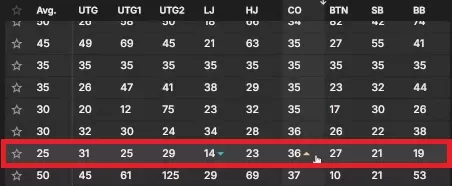
We're going to be using this sim right here. Average stack 25bb. We have opened off 36bb, the button has three-bet us off 27bb.
All right, first spot we're going to look at is with a flush draw.
Let's again have a look at bubble factors to begin. Pretty high risk premium here for both players. Cutoff has 9.4, button has 12.4—so kind of similar and reasonably high for both players. We can see that once it checks to the button here, we almost exclusively want to go all-in once we put money into the pot. We do some 40% pot bets as well, but mostly we just want to jam for 2.2x pot.

In this pot, it's going to be a bit different in terms of what hands we want to use compared to the previous sims. We can see that we're using Jack-10 suited a lot, we're using Ace-10 offsuit quite a bit. And for the overpairs, we're actually not using the first overpairs, which would be queens and jacks, but we're using kings and aces. If we look at his calling range, it's going to be apparent why we do this: it's because he still has Queens and Jacks in his range.
So, first of all, jamming Kings and Aces becomes better because we get called by Queens and Jacks. Also, Jacks need a bit less protection on this board because it has a gutshot and there's a bit more connectivity to the board. Jamming Jacks becomes less attractive when you have interactivity with a board like this and when you get called by queens, right? So yeah, that's what's going on there.
For the next hand, we're going to look at the same sim, same preflop sim. I'm just going to change the board slightly. We're going to look at instead of .
We're going to see in this one that actually both out-of-position and in-position prefer playing a lot of jams. This is kind of a spot where the first player who jams gets a lot of positive results from doing that.
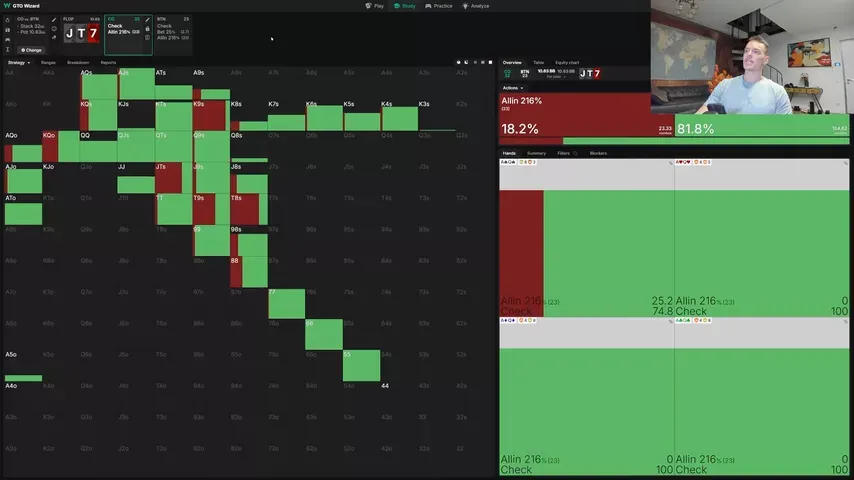
So we can see the hands we want to jam as out-of-position here are hands like 10-9 suited, some mega mastery hands like 10-9 suited, 10-8 suited. We're jamming some big draws like King-9 suited. We're also jamming Ace-Queen, King-Queen. And we can see what happens when we jam here out of position.
The button has to fold some really counterintuitive stuff here. Even pocket queens are not super happy about calling, and at a low frequency, it has to fold. But Ace-Jack offsuit is mostly just out. If you have the ace of spades, that helps a lot for the added equity, but Ace-Jack offsuit without the spade is mostly just out. King-Jack calls more because it has a backdoor straight draw, same with Queen-Jack. But yeah, we get to fold him off hands like nines, eight, top pair, open-enders, King-Queen, Ace-King in the bin.

If we check instead of jamming, he also plays a lot of all-in with some of these hands that we get him to fold by jamming ourselves. We get him to fold ace-eight hands, of course, which will now jam. We get him to fold King-Queen, Ace-King. So a lot of these hands that he jams, we get to fold. And when he jams, now we have to start folding a lot of the hands that we were jamming before—hands like 10-9 suited, 10-8 suited, Ace-Queen, King-Queen, even Ace-Jack offsuit. Stuff that we were jamming, that now has to fold. We even have to fold pocket Queens at a decent clip here.
So it's an interesting spot where basically the first person to jam gets a lot of fold equity. By lead jamming the flop as the cutoff here, we basically steal the fold equity from the button player, which is kind of a cool concept.
All right, so the last couple of spots we're going to be looking at are big blind defending, both as covering stack and covered.

The first one we'll be looking at is this one: a very shallow final table, average stack 20 big blinds, button opening off 16 into 14 and 24.
First of all, let's have a look at this flush draw board. Very good board for the big blind, of course. Looking at risk premiums again, we can see for the big blind here 8%, for the button 12%. So quite a lot higher for the button but reasonable risk premium for both players.
The big blind might actually lead jam for two and a half times pot, almost a third of the time here. A lot of the hands he's using are going to be combo draws, like Queen-4 of spades, even queen-four with no spade—simply this open under. He's going to be using a lot of stuff down here like pair-straight draw type hands. He's also going to be using just overcard stuff like Jack-9 with a jack of spades, for example. Not so intuitive to find these ones, I think.
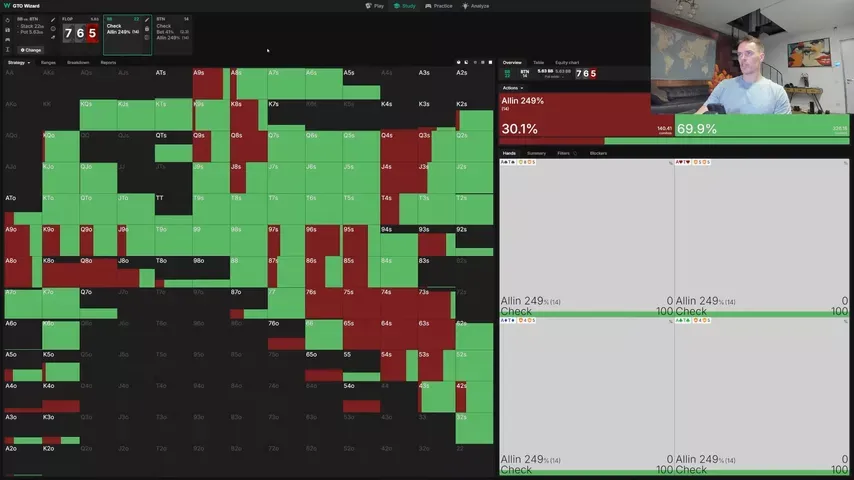
Open-enders kind of easy to find, some like Ace-10 offsuit with the ace of spades. Another kind of counterintuitive one but one that has really nice mega master effects.
Let's have a look at what hands the button is calling here and why Ace-10 offsuit with ace of spades is a good jam. If we jam Ace-10 offsuit, we, for example, get called by Ace-8 offsuit and Ace-9 suited, which is kind of cool. We get called by some of these combo draws and stuff like that. So we get called by some of those hands but also fold out a lot of hands that we are behind.
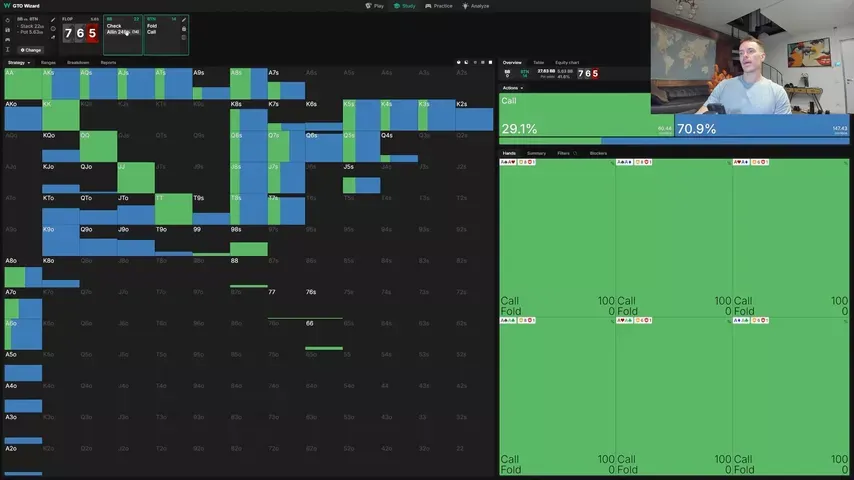
All right, so the last spot we're going to be looking at is the button versus big blind spot again, but this time the button is covering and the big blind is covered. Again, we're going to look at a very shallow stack final table, average stack 20 big blinds, so quite high risk premiums here.
Last board here we're going to look at ( ) —let's again have a quick look at risk premiums. I think that's always a good idea to keep in mind when looking at ICM spots. Big blind here almost 11% risk premium, button 7.5%, so reasonable risk premium for both but not massive.
We can see that the blind here, covered, is jamming for 2.7x pot a quarter of the time. He also uses 40% pot bets sometimes, but the majority sizing is just going to be all-in—give me the pot right now.

Again, kind of intuitive what kind of hands we're jamming: top pairs, very attractive candidates for bluffs. We're using quite a big mix of hands. Again, we're using some of these kind of weakish hands like overpairs with a gutshot, which will have very nice mega master effects. Of course, some like Ace-6 and King-6, very popular candidates. Some stuff like these combo draws, gutshots, flush draws, stuff like that.
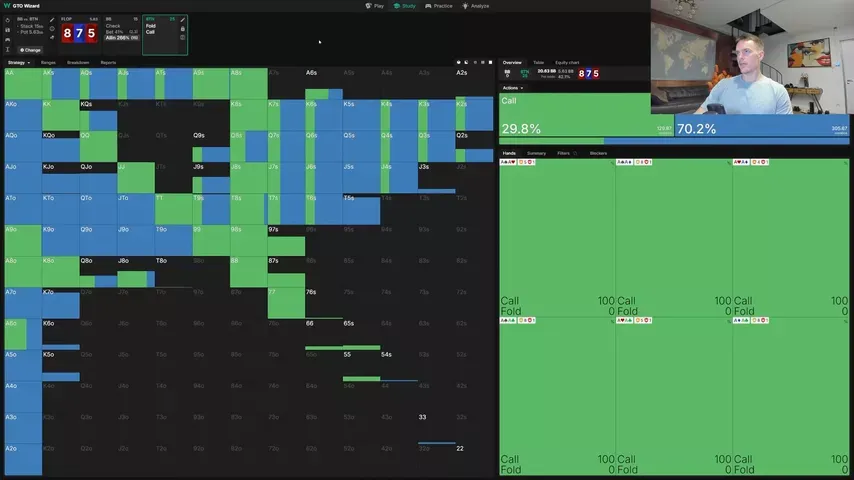
Again, I think it's kind of interesting to see the calling range. How does our opponent react when we jam these hands? Here we can see that again our opponent has to fold some top pairs—Queen-8, Jack-8 mostly—or 50/50 sometimes calling, sometimes folding depending on suits. He has to fold ace-six a lot. King-6 is just out. A lot of these other open-enders can only call if they have flush draws to go. Ace-6 also calls if it has backdoor flush draw sometimes, even without. A lot of these middle pairs out, all of the bottom pairs out except for 6-5 where we have an open-ender as well.
So yeah, we can see again folding out some really strong hands with this play and kind of taking the initiative away from our opponent.
As with everything in poker, there is never one simple reason to explain anything. I believe there are a couple of main reasons for this play though, and those would be the following:
- Maintaining stack is important and more important usually than building a stack; i.e., chips that we lose are worth more than the chips that we gain.
- Taking down a small pot now is better than risking losing a big pot later.
- We avoid getting checked and having to fold hands with decent equity, which is a big win.
- We avoid scare cards on the turn or river—avoiding cards on future streets that will lower the strength of certain holdings; i.e., if you hold pocket Nines on , you have a really strong hand right now, but there aren't really that many safe turn cards where you can happily put more money into the pot.
- Lastly, we take the initiative away from our opponent and steal the fold equity, so to say.
Next up, when does this happen?
Usually, it's on boards where equities will shift a lot on future streets. Mostly it's on low- to middling flush draw boards, but even on boards like flush draw, I've seen it happen, although at lower frequency. I didn't find any monotone boards where this occurs, so mostly from what I could tell, it's on rainbow or flush draw boards.
Usually, it's also when both players have some risk premium but not super big risk premiums.
Finally, hand selection for the all-in range: usually, I think the value portion is going to be quite intuitive. We use value hands in the 40 to 80% equity buckets, meaning strong hands but not the really nutted stuff.
Our bluffs are usually a bit tougher to find, in my opinion. They're usually hands that share cards with a big part of our value range; i.e., if it's a 10-high board and we're shoving a lot of Jacks, Queens, Kings, we draw bluffs from Queen-Jack, King-Jack, King-Queen, stuff like this. We also jam some of the big AX hands like ace-queen offsuit, which will typically have some pretty nice mega master effects, i.e., folding out a lot of better hands on the flop while also getting called by a few worse ones like big flush draws. High equity draws are also used in some spots.



